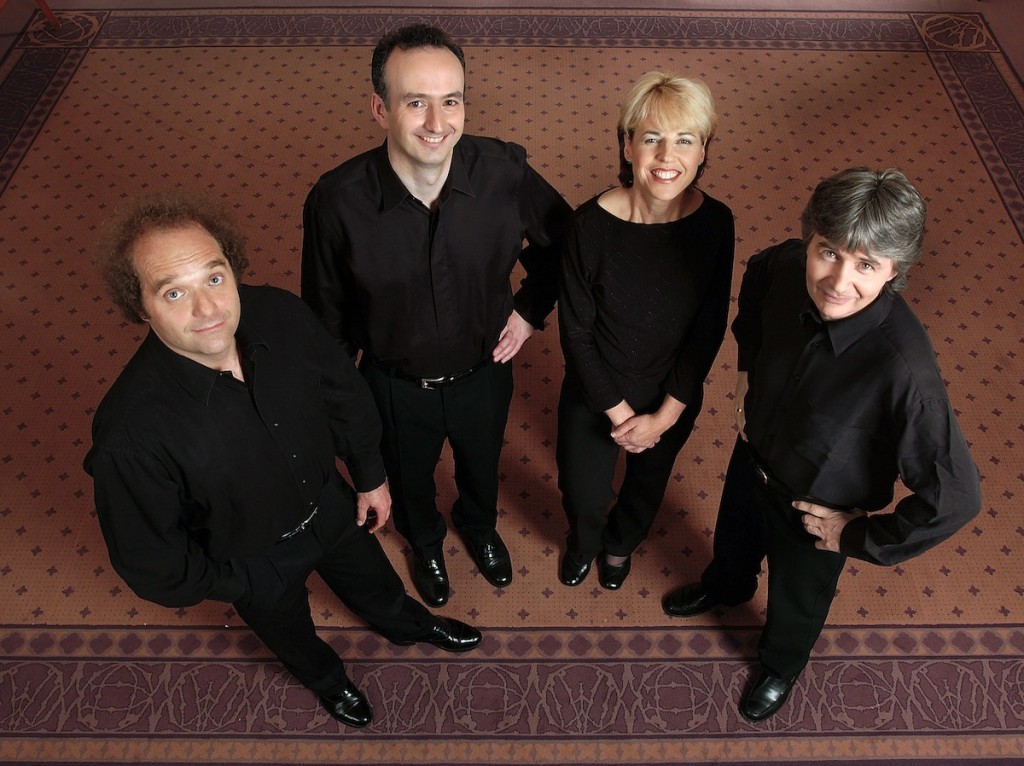Compelling and mysterious, the inner Bartók is explored by the Takács Quartet

The Takács Quartet performed the first program of Bartok’s complete quartets Saturday at Zankel Hall. Photo: University of Colorado
The Takács Quartet has been the leading interpreter of the Bartók string quartets since the late 1990s release of the complete cycle on Decca. Since then, they have made the key personnel change of replacing violist Roger Tapping with former San Francisco Symphony principal violist Geraldine Walther. Some combination of this and the inescapable passage of time have seasoned the quartet’s playing into the evocative and involving expression they showed Saturday night at Zankel Hall.
The concert was the first of two covering the complete Bartók quartets. Heard Saturday were the odd-numbered works: No. 1, Op. 7, No. 3 and No. 5.
For a composer whose inner life is mostly a mystery, the first String Quartet is almost embarrassingly revealing. The mournful opening statement is musically related to his First Violin Concerto, written for violinist Stefi Geyer. Bartók had a burning and unrequited passion for Geyer, and the dirge-like opening movement is the public experience of this failed romance.
The remaining movements are a scherzo and a lively finale. They move Bartók emotionally and musically into the present, exorcising both Geyer and the legacy of Wagner. The descending sixth that opens the piece is an inversion of the same interval from the Prelude to Tristan und Isolde, and the constantly evasive tonal center of the first movement yearns for transfiguration in the brief moments where it rests on A major and D major chords. But it is as unstable and expressionistic as Verklärte Nacht.
In the ensuing allegro come the hallmarks that make Bartók a unique, and uniquely important composer. The emotional and intellectual intensity still simmer, but they are subsumed under a creative and fascinating mix of rigorously complex structures and earthy rhythms and phrases. The flow of music is interrupted by sounds that are provocative or sarcastic, although it’s never clear if the object is our thinking, other music, or Bartók himself.
There is a waltz in the second movement and a rondo in the finale, but the rhythms seem off-kilter and the lines have an unfamiliar logic. This is the sound of Bartók side-stepping the flow of musical history that, in another part of Europe, pushed Schoenberg into atonality. As much an ethnomusicologist as composer, Bartók was already developing the synthesis of small-scale structure and ethnic Hungarian, Romanian and Slovakian music that he transcribed on long trips through the countryside.
These elements are homogenized into the composer’s special sound in the String Quartet No. 3, from the late 1920s. The peasant dance rhythms are wilder, the tonality clearly modal, the phrasing more parlando. To this add the increased use of effects like sul ponticello and glissando, and the result is music that has tremendous clarity of form, but arrives in a complex shape unlike that of any other composer.
In Bartók’s hands, sonata-allegro and counterpoint take on entirely new meanings. Musical structure is built on the intervals between pitches, and compared to Bach or Beethoven, the intervals in this quartet are claustrophobically small: major and minor seconds. With the continuous, even aggressive energy, the effect of the piece, and that of the Quartet No. 5, is both beautiful and unsettling, like hearing an exquisitely articulated stream of incomprehensible language.
Quartet No. 5 was written in four weeks, an astonishingly compressed period considering the density of ideas and invention. Bartók was drawn to symmetry in form, but could not resist tinkering with repeated material; his symmetry is made out of constant variations, challenging to work out and through.
The rhythmic force in the fast outer movements, and the third, middle one, and the spooky mystery of the second and fourth are unsurpassed in classical music. Bartók inverts the convention of dotted rhythms to push the music forward: he makes all the beats strong and the music maintains equilibrium through forward motion, like an out-of-control runner trying to keep from falling. And the haunting music of the adagio and andante sections has the ghostly call of lost memories.
The Takács played the Quartet No. 5 with the deepest intuitive feeling. The playing in the First and Third Quartets was excellent, completely assured and sympathetic, but this was something special. The compelling qualities of objectivity and wild intensity in Bartók’s music are difficult to reconcile because they are so strange, and his transformation of ethnic language into an abstract form is an act of ventriloquism, the use of different voices to say things that he, perhaps, did want to have ascribed directly to himself.
Beyond the challenge of the notes, there is the expressive demand that the musicians play his music with utter fervor yet without revealing his own mysteries. That is the true Bartók, and the Bartók given to us by the Takács members.
The Takács Quartet plays Bartók String Quartets Nos. 2, 4 and 6 3 p.m. today at Zankel Hall. carnegiehall.org


